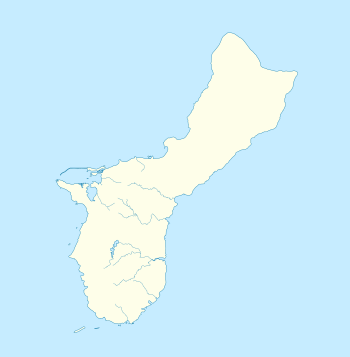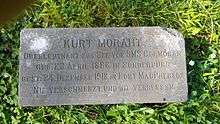SMS Cormoran (1909)
SMS Cormoran or SMS Cormoran II was built at the Schichau shipyard in Elbing, Imperial Germany in 1909 for the Russian merchant fleet and was named Ryazan (Rjasan or Rjäsan, from the Russian town of Ryazan). She was used by imperial Russia as a combination passenger, cargo and mail carrier on North Pacific routes.
.jpg) SMS Cormoran | |
| History | |
|---|---|
| Name: | Ryazan |
| Namesake: | Ryazan |
| Builder: | Schichau Yard at Elbing |
| Launched: | 1909 |
| Out of service: | 4 August 1914 |
| Fate: | captured by SMS Emden |
| History | |
| Name: | SMS Cormoran aka SMS Cormoran II |
| Namesake: | SMS Cormoran I |
| Acquired: | 4 August 1914 |
| Commissioned: | 10 August 1914 as SMS Cormoran II |
| Fate: | scuttled at Apra Harbor, Guam on 7 April 1917 |
| General characteristics | |
| Displacement: | 3,500 t (3,400 long tons) |
| Speed: | 17 kn (31 km/h; 20 mph) |
| Armament: | 8 × 105 mm (4.1 in) quick-firing guns |
 | |
| Location | Apra Harbor |
| Nearest city | Piti, Guam[1] |
| Coordinates | 13°27′33″N 144°39′15″E |
| Area | 0.1 acres (0.040 ha) |
| Built | 1909[1] |
| NRHP reference No. | 75002156[2] |
| Added to NRHP | April 4, 1975 |
History
The Ryazan was captured southeast of the Korean peninsula by the German light cruiser SMS Emden on 4 August 1914 as the first prize of World War I from the Russian empire.[3] She was taken to Tsingtao in the German colony Kiautschou, where she was converted to an armed merchant raider. The new Cormoran replaced the original SMS Cormoran, a small shallow draft cruiser that had a long Imperial Navy career in the Pacific, having taken part in the events that brought Kiautschou into the German colonial empire in 1897–98. The old Cormoran was laid up at Tsingtao with serious maintenance issues and unable to go to sea, and her armaments were transferred to the captured merchant ship.
On 10 August 1914, the new Cormoran (or Cormoran II) left Tsingtao harbor and sailed through the South Pacific region. After Japan declared war on the German Empire, her warships discovered and pursued the Cormoran, forcing her to seek refuge in Apra Harbor, in the U.S. Territory of Guam, on 14 December. Having expended most of her fuel raiding commerce, her crew burned much of her woodwork in the boilers in order to make port. With only 50 t (55 short tons) of coal remaining in her bunkers, her captain requested provisions and 1,500 t (1,700 short tons) of coal in order to reach German ports in East Africa.[4]
Due to strained diplomatic relations between the United States and Germany, plus the limited amount of coal stored at Guam, Governor William John Maxwell refused to supply Cormoran with more than a token amount of coal. He ordered the ship to leave within 24 hours or submit to detention.[4] This created a standoff between the German crew and the Americans that lasted nearly two years, until Governor Maxwell was involuntarily placed on the sick list and replaced by his subordinate, William P. Cronan, who decided the German crew should be treated as guests of the United States. The Cormoran was not allowed to leave the harbor, but the crew were treated as friends, achieving a minor celebrity status on the island.
When the U.S. Congress declared war on Germany on 7 April 1917, Captain Adalbert Zuckschwerdt scuttled his ship rather than surrender her. This resulted in the "first shot" of the war between the U.S. and Imperial Germany.[5] Sailors at Guam saw the German crew preparing to scuttle the ship and fired a shot across their bow in an effort to stop them. However, the German sailors continued to scuttle the vessel, and nine crew members perished (probably in the explosion that sank her). They were buried with full military honors in the naval cemetery at Agana. After the American sailors rescued and made prisoners the surviving Germans, Governor Cronan congratulated Captain Zuckschwerdt for the bravery of his men. The U.S. Navy later conducted a limited salvage operation and the ship's bell was recovered. It is exhibited at the U.S. Naval Academy Museum at Annapolis, Maryland. Other artifacts have been removed by divers over the years.
The German crew was initially imprisoned in Fort Douglas, Utah. In April 1918, all remaining prisoners of war from Cormoran and SMS Geier were transferred from Fort Douglas to Fort McPherson, Georgia.[6] All returned home on 7 October 1919, almost a year after the war's end.
The wreck of the Cormoran II rests 110 ft (34 m) below the surface on her starboard side. A Japanese cargo ship, the Tokai Maru, sunk by the submarine USS Snapper, leans against her screw. The wreck is one of the few places where divers can explore a World War I shipwreck next to a ship from World War II.[7]
In 1975, the wreck was placed on the National Register of Historic Places.[2] She was listed because of her association with World War I.[8]
On 11 September 2011 a headstone was found in Westview cemetery in Atlanta Georgia bearing the name Kurt Moraht. The headstone, written completely in German, identifies the resting place of Oberleutnant Kurt Moraht of SMS Cormoran (See photo below). It lists his birth date as 28 April 1886 and his death as 24 December 1918, and identifies the place of death as Fort MacPherson, Georgia.[9] Another source revealed that during the prisoner transfer from Utah to Atlanta 7 crew members attempted escape and that some were killed in the attempt but it is not known how many were killed and how many were recaptured. Moraht reportedly died of pneumonia while still in prison at Fort McPherson. Some records indicate all prisoners of the SMS Cormoran were returned home at the end of the war but Moraht was certainly not among them.
Partial list of crew members

- Henry Bock (Leutnant Bock's was the first German naval officer sword surrendered in the Pacific)[10]
- Herman Berka (Cormoran's chief engineer)[11]
- Wilhelm Hermann Grallert, Lindenau, Kreis Landeshut, Niederschlesien, Prussia
- Fritz August Hermann Kutz, Labes, Kreis Regenwalde, Pommern, Prussia
- Jakob Runck, Landau, Pfalz, Bavaria
- Emil Bischoff, Unterschefflenz, Baden, Germany
- Ernest Max Adolf, Freiburg/Br, Germany
- Johannes Heinrich Dammann, Nutteln, Schleswig-Holstein
- Kurt Moraht
Notes
- NPS Archeology Program: Abandoned Shipwreck Act Guidelines
- "National Register Information System". National Register of Historic Places. National Park Service. July 9, 2010.
- Van der Vat, Gentlemen of War, p. 36
- "Germans Destroy Interned Gunboat in Harbor at Guam". Evening Star. Washington, D.C. 7 April 1917. p. 1. Retrieved 7 April 2017.
- Robert F. Rogers (January 1995). Destiny's Landfall: A History of Guam. University of Hawaii Press. pp. 139–. ISBN 978-0-8248-1678-0.
- "Interned Sailors sent away from Salt Lake". The Ogden Standard. Ogden City, Utah. 3 April 1918. Retrieved 7 April 2017.
- "Tokai Maru Shipwreck in Guam". Micronesian Divers Association. Archived from the original on 2007-09-30. Retrieved 2007-11-27.
- Lotz, David T. (1974). SMS Cormoran National Register of Historic Places Inventory-Nomination Form. Washington, D.C.: National Park Service.
- Kurt Moraht at Find a Grave
- "More Prisoners are Placed at Camp Douglas". The Ogden Standard. Ogden City, Utah. 21 June 1917. p. 9.
- "German Prisoner Insane from Brooding on War". Evening Public Ledger. Philadelphia, PA. 24 November 1917. p. 2. Retrieved 7 April 2017.
Sources
- Burdick, Charles Burton (1979). The Frustrated Raider: The Story of the German Cruiser Cormoran in World War I. Carbondale: Southern Illinois University Press. ISBN 978-0-8093-0899-6. OCLC 4194620.
- Van der Vat, Dan (1984). Gentlemen of War, The Amazing Story of Captain Karl von Müller and the SMS Emden. New York: William Morrow and Company, Inc. ISBN 0-688-03115-3.
- Oelke-Farley, James. "SMS Cormoran Crew List". Guampedia Foundation.
- Bruce McClendon, Atlanta Westview Cemetery